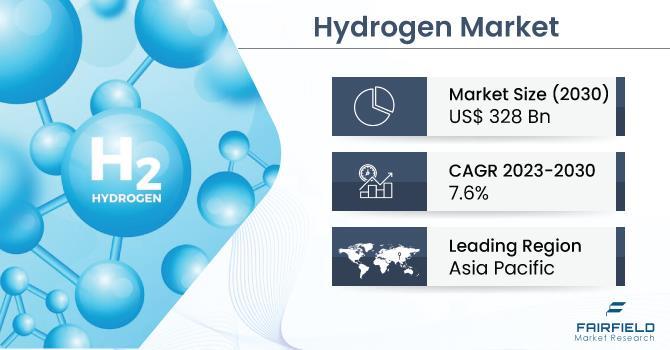Hydrogen Market

Hydrogen, a crucial element in the clean energy sector, is gaining momentum as a key player in future energy transitions. The global hydrogen market, currently valued at approximately US$185 billion, is projected to grow significantly. By the end of 2030, the market size is expected to reach US$328 billion, driven by advancements in technology, government support, and increasing demand across various sectors.
For More Industry Insight: https://www.fairfieldmarketresearch.com/report/hydrogengeneration-market
Market Dynamics and Current State
Hydrogen is already produced on a commercial scale, primarily for industrial applications. Despite its current contribution of less than 5% to the global energy mix, hydrogen’s potential in clean energy transitions remains largely untapped. Governments worldwide are investing heavily in hydrogen technologies, aiming to boost its use beyond its current applications in oil refining and chemical manufacturing. Notably, hydrogen could potentially account for about a quarter of global energy consumption by 2050.
Key hydrogen technologies such as Direct Reduced Iron (DRI) for steel manufacturing, ammonia use in shipping vessels, and synthetic fuels for aviation are still in the developmental phase. However, the technology holds promise for future applications in transportation, including trucks, airplanes, and ships, as well as in producing fertilizers, generating heat and power, and supporting heavy industries like steel and cement production.
Key Findings from the Report
• By 2030, the hydrogen market size is projected to reach US$328 billion.
• The push for global sustainability and clean energy is setting up a robust future hydrogen ecosystem.
• Hydrogen generation capacity needs significant expansion to meet the demands of mainstream applications like fuel cell vehicles.
• Government initiatives will play a crucial role in the growth of the hydrogen industry.
• On-site captive production is expected to maintain a dominant position, holding over 75% of the total market revenue.
• Asia Pacific, led by China, will continue to dominate with over 40% of the global market value.
Growth Drivers and Government Initiatives
Governments around the world are accelerating their sustainability efforts, with numerous countries committing to net-zero emissions targets. The rise of Environmental, Social, and Corporate Governance (ESG) factors is shifting attention towards clean energy markets, including hydrogen. The Paris Agreement and other regulatory frameworks are fostering a supportive environment for hydrogen technologies.
As of early 2021, over 30 countries have established hydrogen roadmaps with national strategies. More than 200 large-scale hydrogen projects, primarily located in Europe, Asia, and Australia, have been announced, with a combined investment value exceeding $300 billion through 2030. Of this, $80 billion is considered mature, indicating that these projects are either in advanced planning stages or already under construction.
Energy giants such as NextEra, Iberdrola, and Uniper are venturing into green hydrogen, challenging the traditional dominance of oil companies. The electric vehicle (EV) boom is expected to enhance hydrogen fuel’s popularity due to its efficiency and reduced charging time. Toyota’s Mirai serves as an early example of hydrogen fuel cell technology in EVs.
Sustainability Targets and Hydrogen Production
The global hydrogen market is categorized into grey hydrogen (without carbon capture and storage), blue hydrogen (with carbon capture), and green hydrogen. In 2022, grey hydrogen held more than 90% of the market share. However, blue and green hydrogen are anticipated to grow at Compound Annual Growth Rates (CAGR) of 24.1% and 17.8% respectively from 2023 to 2030.
Blue hydrogen, produced through steam methane reforming or auto thermal reforming, is currently the most cost-effective method. It involves capturing and storing carbon emissions, making it a viable option for large-scale hydrogen production. Green hydrogen, produced via electrolysis using renewable energy sources, is expected to see significant growth as sustainability targets push for cleaner production methods.
Hydrogen Generation Market and Applications
The global hydrogen market is segmented by application into refining, ammonia production, methanol, iron and steel, chemicals, transport, and others. In 2022, the refining sector dominated, accounting for 48% of the market value. The transport sector is projected to experience the strongest growth by 2030, driven by increased demand for hydrogen fuel cell vehicles.
Despite the potential, hydrogen generation for fuel cell vehicles is still developing, with current applications predominantly in industrial sectors like oil refining and steel production. The pace
of adoption in areas such as transport, building, and power generation needs to accelerate to fully realize hydrogen's role in clean energy transitions.
Regional Insights and Growth Opportunities
Europe and North America are expected to see substantial growth in hydrogen projects by 2030. Europe, in particular, is leading in terms of planned hydrogen generation projects, accounting for over 60% of the total announced clean hydrogen supply volumes. Asia Pacific, with China as a major player, remains the largest consumer of hydrogen, contributing over 60% of the region’s demand.
The mobility sector and new industrial uses like steelmaking receive approximately 30% of all announced investments, while existing industrial applications like ammonia and refining receive about 25%. Announced investments in clean hydrogen have more than tripled since 2021.
Key Players and Notable Developments
Key players in the global hydrogen market include Royal Dutch Shell, TotalEnergies, Adani Green, Air Liquide, Air Products, Bloom Energy, CTP Hydrogen, Chevron Hydrogen Company LLC, Doosan Fuel Cell, FuelCell Energy Inc., Linde Plc, and Plug Power Inc.
Recent notable developments include Shell Plc’s construction of the largest renewable hydrogen plant in Europe, set to be operational by 2025, and the strategic partnership between Adani and TotalEnergies to create the world’s largest green hydrogen ecosystem.
